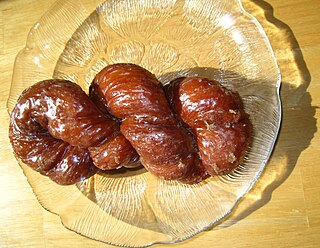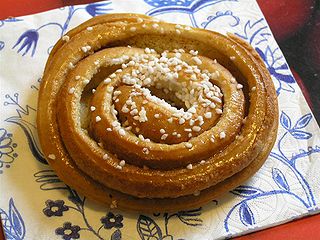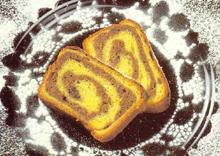
Puff pastry, also known as pâte feuilletée, is a flaky light pastry made from a laminated dough composed of dough and butter or other solid fat. The butter is put inside the dough, making a paton that is repeatedly folded and rolled out before baking.

Pastry is baked food made with a dough of flour, water and shortening that may be savoury or sweetened. Sweetened pastries are often described as bakers' confectionery. The word "pastries" suggests many kinds of baked products made from ingredients such as flour, sugar, milk, butter, shortening, baking powder, and eggs. Small tarts and other sweet baked products are called pastries as a synecdoche. Common pastry dishes include tarts, quiches, croissants, and pasties.

A doughnut or donut is a type of food made from leavened fried dough. It is popular in many countries and is prepared in various forms as a sweet snack that can be homemade or purchased in bakeries, supermarkets, food stalls, and franchised specialty vendors. Doughnut is the traditional spelling, while donut is the simplified version; the terms are used interchangeably.

A pie is a baked dish which is usually made of a pastry dough casing that contains a filling of various sweet or savoury ingredients. Sweet pies may be filled with fruit, nuts, brown sugar, sweetened vegetables, or with thicker fillings based on eggs and dairy. Savoury pies may be filled with meat, eggs and cheese (quiche) or a mixture of meat and vegetables.

A cruller is a deep-fried pastry like a doughnut popular in Europe and North America often made from a rectangle of dough with a cut made in the middle that allows it to be pulled over and through itself, producing twists in the sides of the pastry. The cruller has been described as resembling "a small, braided torpedo". Some other cruller styles are made of a denser dough somewhat like that of a cake doughnut formed in a small loaf or stick shape, but not always twisted. Crullers may be topped with powdered sugar or icing.

A cinnamon roll is a sweet roll commonly served in Northern Europe and North America. In Sweden it is called kanelbulle, in Denmark it is known as kanelsnegl, in Norway it is known as kanelbolle, skillingsbolle or kanelsnurr, in Finland it is known as korvapuusti, in Iceland it is known as kanilsnúður, and in Estonia it is known as kaneelirull. In Austria and Germany it is called Zimtschnecke.

Apple strudel is a traditional Viennese strudel, a popular pastry in Austria, Bavaria, the Czech Republic, Northern Italy, Slovenia, and other countries in Europe that once belonged to the Austro-Hungarian Empire (1867–1918).

Pastilla is a North African meat or seafood pie made with warqa dough (ورقة), which is similar to filo. It is a specialty of Morocco and Algeria. It has more recently been spread by emigrants to France, Israel, and North America.

The Chelsea bun is a type of currant bun that was first baked in the 18th century at the Bun House in Chelsea, an establishment favoured by Hanoverian royalty accustomed to similar pastries in their native cuisine. The shop was demolished in 1839.

A nut roll is a pastry consisting of a sweet yeast dough that is rolled out very thin, spread with a nut paste made from ground nuts and a sweetener like honey, then rolled up into a log shape. This 'log' is either left long and straight or is often bent into a horseshoe shape, egg washed, baked, and then sliced crosswise. Nut rolls resemble a jelly roll but usually with more layers of dough and filling, and resemble strudels but with fewer and less delicate dough layers. Fillings commonly have as their main ingredient ground walnuts or poppy seeds.

Bizcocho is the name given in the Spanish-speaking world to a wide range of pastries, cakes or cookies. The exact product to which the word bizcocho is applied varies widely depending on the region and country. For instance, in Spain bizcocho is exclusively used to refer to sponge cake. In Uruguay, most buttery flaky pastry including croissants are termed bizcocho, whilst sponge cake is called bizcochuelo. In Chile, the Dominican Republic and Bolivia bizcocho refers to a sweet dough (masa) baked with local ingredients, similar to the bizcocho from Spain. In Ecuador the dough of a bizcocho can either be sweet or salty. The US state New Mexico is unusual in using the diminutive form of the name, bizcochito, as the name for a locally developed and very popular cookie.

Monkey bread is a soft, sweet, sticky pastry served in the United States for breakfast or as a treat. It consists of pieces of soft baked dough sprinkled with cinnamon. It is often served at fairs and festivals.

A Franzbrötchen is a small, sweet pastry baked with butter and cinnamon, similar to a cinnamon roll. Sometimes other ingredients are used as well, such as chocolate or raisins. It is a type of pastry commonly found in northern Germany, especially Hamburg, and it is usually served for breakfast, but is also enjoyed along with coffee and cake. As its name indicates, the Franzbrötchen was probably inspired by French pastries. Originally, it could be found only in the region of Hamburg, but now Franzbrötchen are also sold in Bremen, Berlin, and other German cities.

A palmier, pig's ear, palm heart, or elephant ear is a French pastry in a palm leaf shape or a butterfly shape, sometimes called palm leaves, cœur de France, French hearts, shoe-soles, or glasses that was invented in the beginning of the 20th century.

Klenät, kleinur, klena, klejne, kleina, kleyna, and fattigmann are all names for Angel wings, a fried pastry common in the Nordic countries as well as the rest of Europe and the United States. In nearby countries and Eastern European countries. The name is related to klen, the Swedish term for "slender", but is originally of Low German origin, which may indicate that the pastry was originally German. It is made from flattened dough cut into small trapezoids. A slit is cut in the middle and then one or both ends pulled through the slit to form a "knot". The kleina is then deep-fried in oil or another kind of fat. Subsequently can be sprinkled with powdered sugar and cinnamon.

Pain aux raisins, also called escargot or pain russe, is a spiral pastry often eaten for breakfast in France. Its names translate as "raisin bread", "snail" and "Russian bread" respectively. It is a member of the pâtisserieviennoise family of baked foods.

Međimurska gibanica(pronounced [mɛdʑǐmuːrska 'ɡibaŋitsa]; Medjimurian layer cake) is a type of gibanica or layer cake originating from Međimurje County, Croatia. It is made of puff pastry and four fillings: nuts, fresh cheese, poppy seeds and apples, as well as of many additional ingredients. It is a traditional dish especially popular in Northern Croatia, rich in flavour and full of calories, a delicacy which is an integral component of Croatian cuisine.

A sweet roll or sweet bun refers to any of a number of sweet, baked, yeast-leavened breakfast or dessert foods. They may contain spices, nuts, candied fruits, etc., and are often glazed or topped with icing. Compared to regular bread dough, sweet roll dough generally has higher levels of sugar, fat, eggs, and yeast. They are often round, and are small enough to comprise a single serving. These differ from pastries, which are made from a paste-like batter; from cakes, which are typically unleavened or chemically leavened; and from doughnuts, which are deep fried.

















